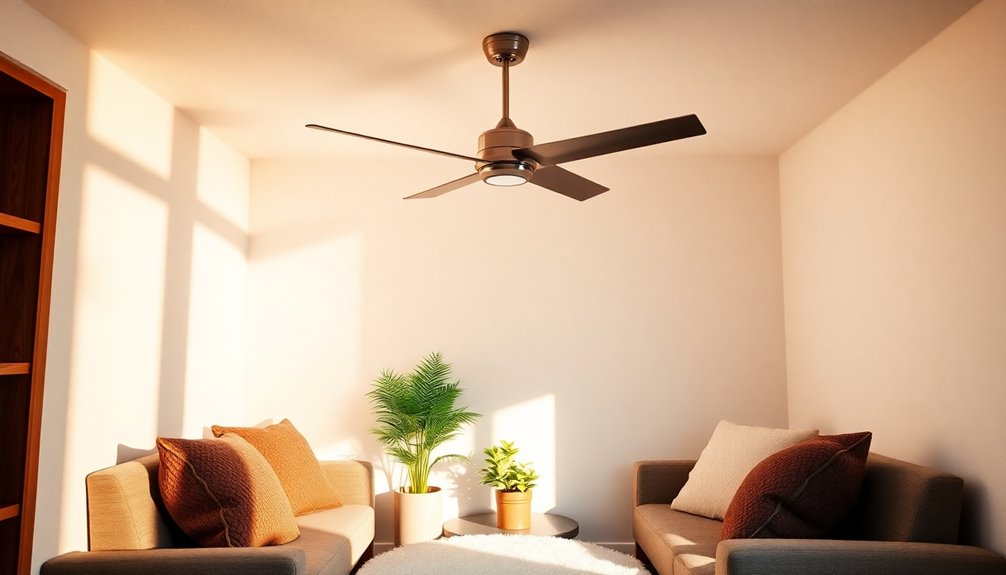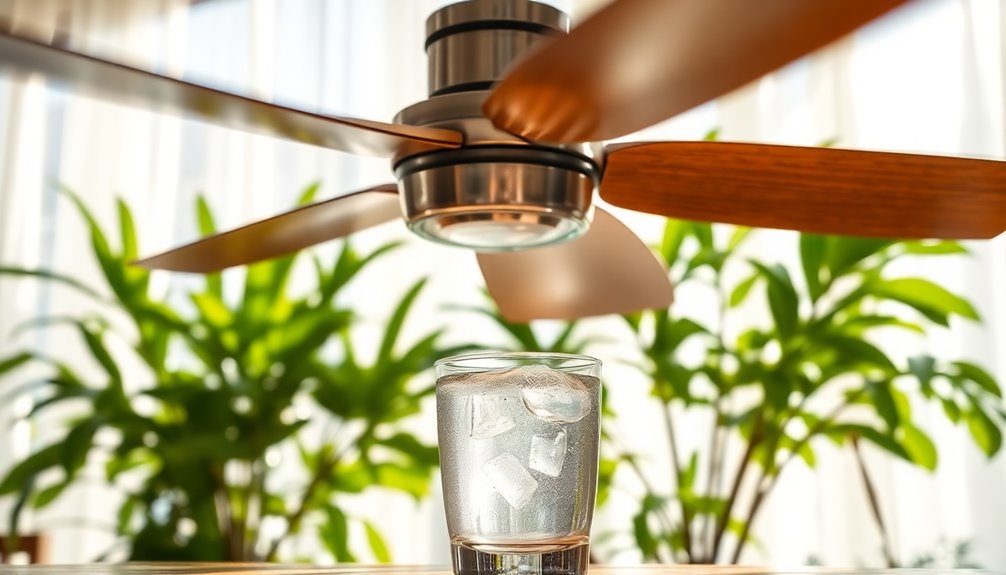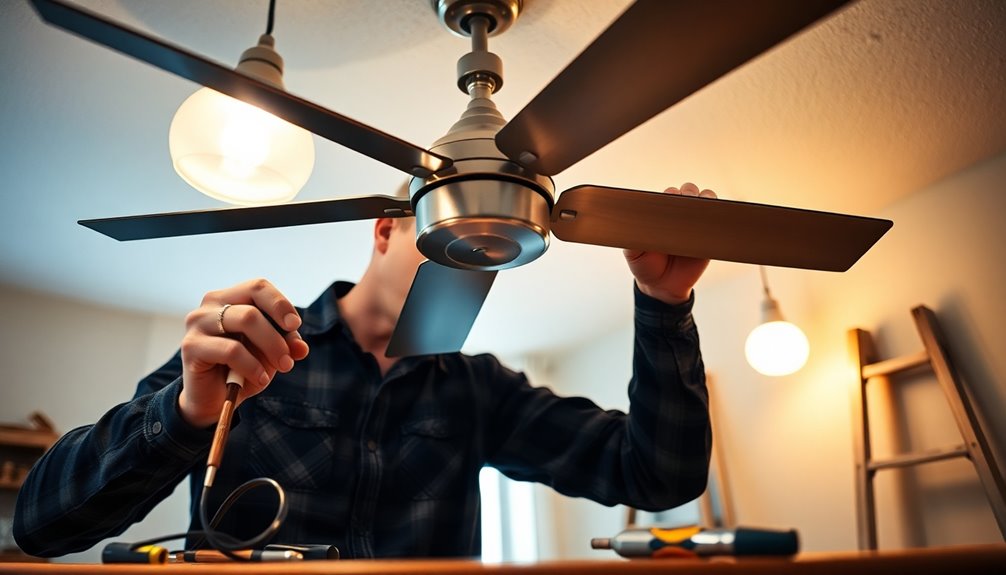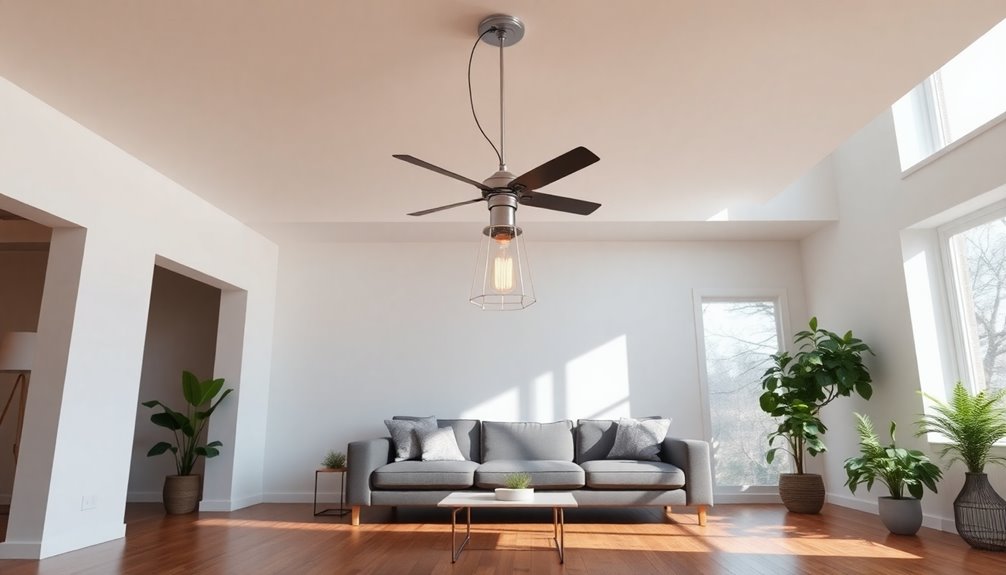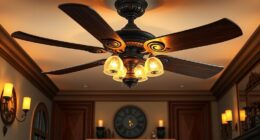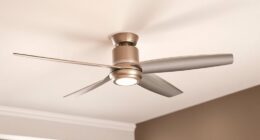To choose a quiet ceiling fan, focus on models with high-quality DC motors that operate smoothly and silently, and select blades designed for minimal noise and wobbling. Guarantee the fan is properly installed with balanced blades and secure mounting to prevent vibrations. Consider features like sound-dampening components and aerodynamic blade designs to maximize quietness. If you keep these factors in mind, you’ll find a fan that keeps your space cool and peaceful—more tips await to help in your search.
Key Takeaways
- Select fans with DC motors for quieter, smoother operation and energy efficiency.
- Choose blade designs and materials that minimize vibration and wobbling.
- Ensure proper installation with secure mounting and balanced blades to prevent noise.
- Look for fans with sound-dampening features like rubber grommets and aerodynamic blades.
- Consider reputable models known for whisper-quiet performance and reliable construction.
Understanding What Causes Ceiling Fan Noise
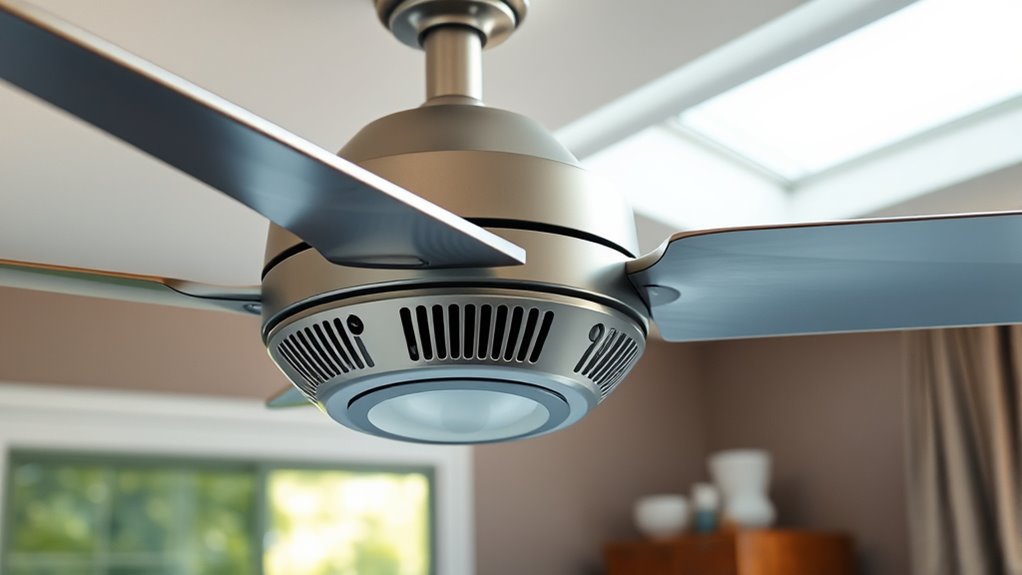
To understand what causes ceiling fan noise, it’s important to recognize that several factors influence how loud a fan can be during operation. The motor plays a key role; higher-quality motors tend to operate more whisper-quiet, while cheaper ones may produce hums or rattles. Using the right fan components can significantly reduce operational noise and improve overall performance. Blade design, material, and balance directly affect noise levels—well-balanced blades move smoothly, reducing vibration and wobbling that cause sound. Proper installation and mounting techniques are essential, as unsteady mounting can lead to vibrations and wobbling, resulting in increased noise from hums to rattles. If the fan isn’t mounted securely, it may wobble or vibrate, amplifying noise. Conversely, fans with aerodynamically designed blades and energy-efficient motors are engineered to minimize sound, creating a quieter, more comfortable environment. Additionally, using the right filtration and pump protection can help ensure that the motor operates smoothly and quietly over time.
Key Features of Quiet Ceiling Fans
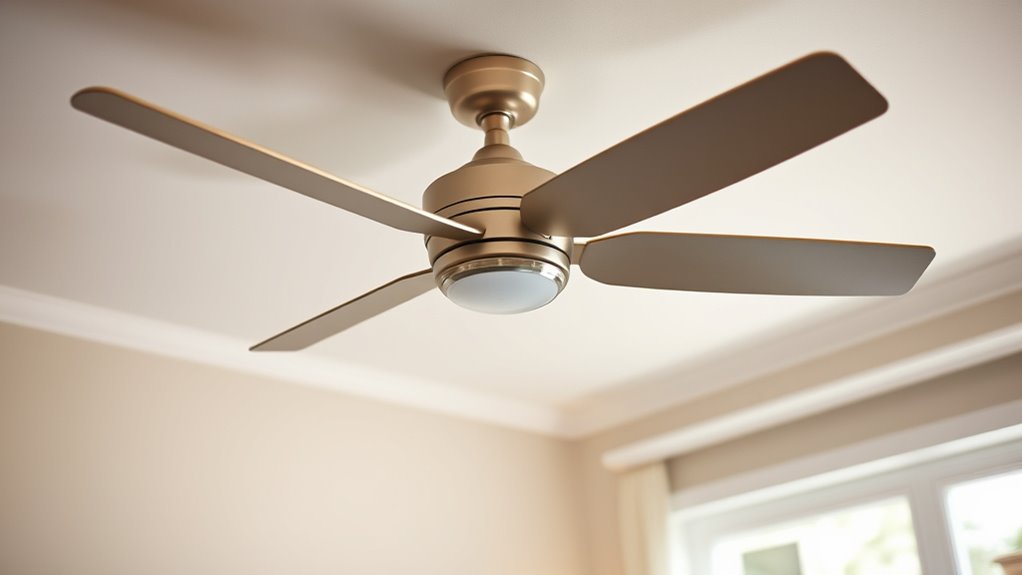
| Feature | Benefit |
|---|---|
| DC motor | Reduces vibration, guarantees quiet operation |
| Blade design | Minimizes noise, improves airflow |
| Precision blades | Stability, less vibration, quieter sound |
| Fan technology | Enhances airflow, maintains low noise levels |
Selecting a Motor and Blade Design for Low Noise
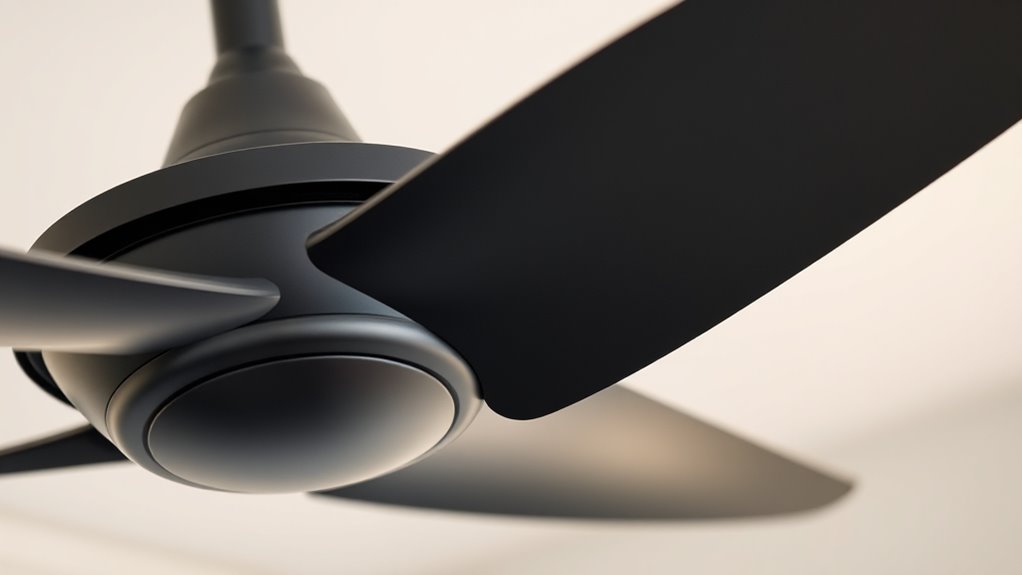
Choosing the right motor and blade design is essential for a quiet ceiling fan. Opt for fans with DC motors, which run more smoothly and quietly than traditional AC motors, thanks to their brushless design. Brushless motor technology not only reduces noise but also improves energy efficiency and durability. Look for balanced blades made from materials like wood or composite to reduce vibrations and noise. The blade pitch and aerodynamic blade design influence airflow efficiency while minimizing turbulence that causes sound. Features like sound-dampening components—rubber grommets and insulation—further cut down operational noise. Proper installation, including wobbling prevention measures, ensures stability and quiet performance. Vibration reduction can be achieved by employing specialized mounting brackets and precise balancing techniques. – Use fans with balanced, aerodynamically designed blades for smooth operation – Choose models with sound-dampening features to cut noise – Ensure proper mounting to prevent wobbling and vibrations – Incorporate AI-driven noise reduction technologies that analyze and minimize operational sounds for optimal quietness
Important Installation Tips for Maintaining Silence
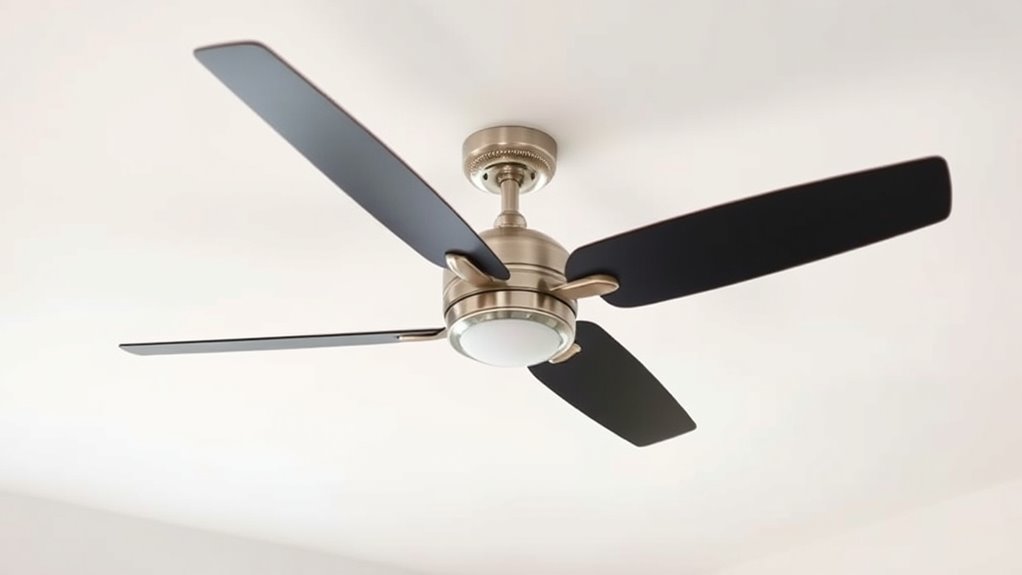
Proper installation plays a vital role in keeping your ceiling fan quiet. Start by ensuring the blades are balanced and securely fastened to prevent wobbling and vibrations that cause noise. A secure mounting helps minimize mechanical noise caused by loose fixtures. Using a high-quality, quiet motor—such as a DC or premium AC model—can significantly reduce operational sound. Proper blade alignment is essential to reduce wobbling and rattling. Install your fan at the optimal height, typically 8-9 feet above the floor, for efficient airflow and quiet performance. Regular maintenance is key; clean blades and motor components to prevent dust buildup, which can increase mechanical noise. Correct installation, combined with ongoing upkeep, significantly enhances silence and ensures your ceiling fan operates smoothly for years. Additionally, selecting a quiet motor designed for minimal noise can further improve overall performance and comfort. Ensuring the mounting hardware is properly secured is crucial, as loose fixtures can cause vibrations and additional noise during operation. Properly balancing the blades can prevent wobbling and prolong the lifespan of your fan. Consulting local resources or experts can help you choose the best professional installation services to ensure optimal silence and safety.
Top Quiet Ceiling Fans Recommended by Experts
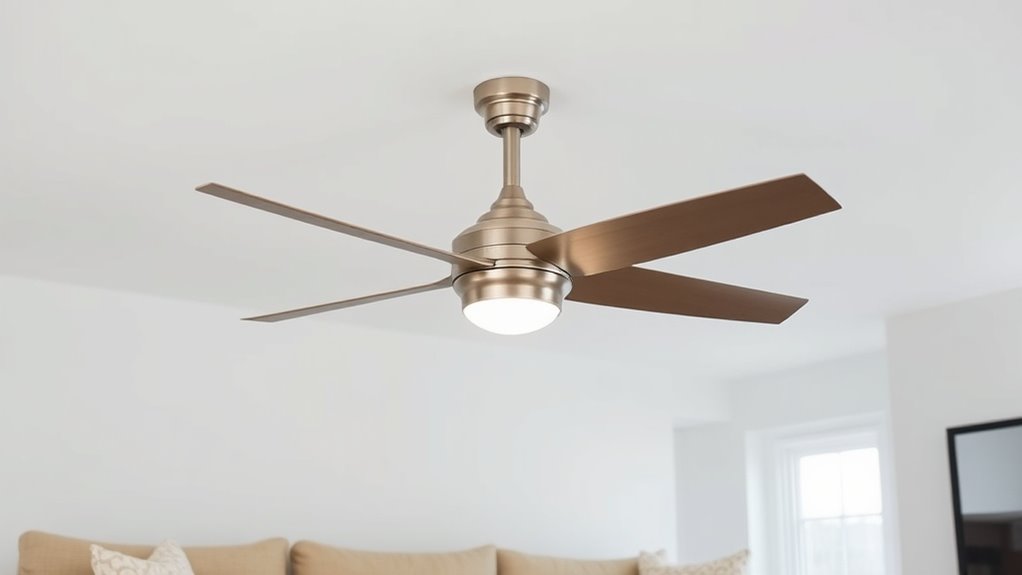
When it comes to selecting a quiet ceiling fan, expert recommendations highlight models that combine advanced motor technology with thoughtful design. Look for ceiling fan models with whisper-quiet operation, ensuring minimal noise during use.
Fans like the Honeywell Carmel deliver a smooth airflow of 5,202 CFM, thanks to high-quality blade design and balanced construction, which help reduce vibrations.
The Aerodyne Indoor Smart Fan with a DC motor operates more quietly than traditional models, offering superior noise reduction and energy efficiency.
Additionally, fans equipped with Hunter’s WhisperWind motors utilize high-grade components to maintain silent operation over time.
Proper installation is essential to preserve their quiet performance, so choose models with thoughtful engineering and quality construction for a peaceful, efficient airflow experience.
Frequently Asked Questions
What Type of Ceiling Fan Is the Quietest?
You want the quietest ceiling fan, and DC motor fans are your best bet. They operate more smoothly and quietly than traditional AC fans.
Look for models with balanced blades, SureSpeed technology, and reversible whisper-quiet motors.
Proper installation also matters—secure mounting and balanced blades minimize noise.
How to Choose a Quiet Fan?
You might think picking a quiet fan is easy, but it’s trickier than it looks. To choose one, look for models with high-quality DC motors—they run silently and save energy.
Check for blades designed for low noise and guarantee proper installation to prevent vibrations. Fans with SureSpeed® tech or aerodynamic blades are perfect for near-silent operation.
Don’t forget to balance blades for extra quiet comfort in your peaceful space.
Is a 52 Inch Fan Too Big for a 12X12 Room?
A 52-inch fan isn’t too big for your 12×12-foot room. It’s actually a great choice because it provides enough airflow without overwhelming the space.
You’ll want to make certain there’s at least 18 inches of clearance from the walls for proper circulation. This size offers a good balance between effective cooling and visual proportion, especially if your ceilings are standard 8 feet tall.
Which Fan Is the Most Silent?
Think of choosing a silent fan like tuning a musical instrument—every part must be perfectly balanced. The quietest fans often feature DC motors, producing noise levels as low as 20-30 decibels.
Fans with WhisperWind technology or SureSpeed innovation are designed for near-silent operation while delivering strong airflow.
Well-balanced blades and proper installation further reduce noise, ensuring your space remains peaceful and serene.
Conclusion
Choosing a quiet ceiling fan is like finding a gentle whisper in a noisy room—you want comfort without the constant hum. By understanding what causes noise, focusing on key features, and ensuring proper installation, you can enjoy cool breezes without the racket. Think of your perfect fan as a silent partner, silently working behind the scenes to keep your home peaceful. With the right choice, you’ll turn your space into a haven of calm and comfort.


